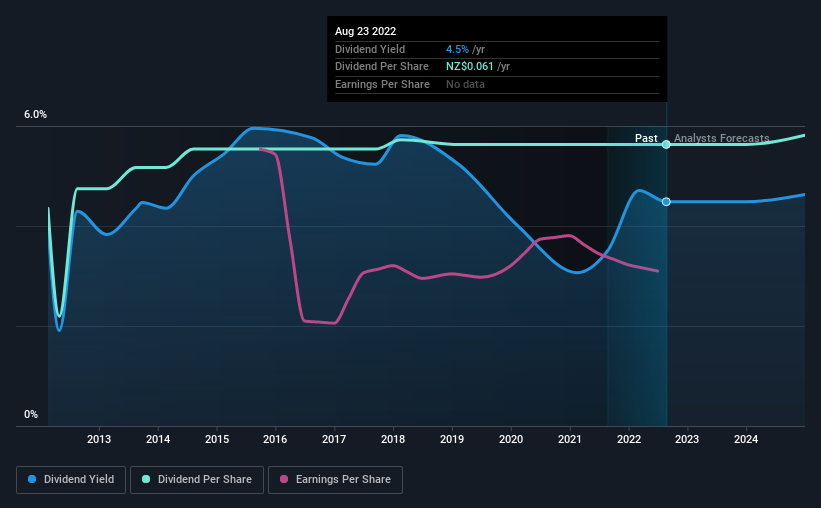NZX (NZSE:NZX) Has Announced A Dividend Of NZ$0.0353
NZX Limited's (NZSE:NZX) investors are due to receive a payment of NZ$0.0353 per share on 23rd of September. This means the annual payment is 4.5% of the current stock price, which is above the average for the industry.
Check out our latest analysis for NZX
NZX Doesn't Earn Enough To Cover Its Payments
Impressive dividend yields are good, but this doesn't matter much if the payments can't be sustained. Before this announcement, NZX was paying out 118% of what it was earning, and not generating any free cash flows either. Paying out such a large dividend compared to earnings while also not generating any free cash flow would definitely be difficult to keep up.
The next 12 months is set to see EPS grow by 13.8%. However, if the dividend continues along recent trends, it could start putting pressure on the balance sheet with the payout ratio reaching 134% over the next year.
Dividend Volatility
The company has a long dividend track record, but it doesn't look great with cuts in the past. The annual payment during the last 10 years was NZ$0.0471 in 2012, and the most recent fiscal year payment was NZ$0.061. This means that it has been growing its distributions at 2.6% per annum over that time. We're glad to see the dividend has risen, but with a limited rate of growth and fluctuations in the payments the total shareholder return may be limited.
NZX May Find It Hard To Grow The Dividend
With a relatively unstable dividend, it's even more important to evaluate if earnings per share is growing, which could point to a growing dividend in the future. Although it's important to note that NZX's earnings per share has basically not grown from where it was five years ago, which could erode the purchasing power of the dividend over time.
An additional note is that the company has been raising capital by issuing stock equal to 12% of shares outstanding in the last 12 months. Regularly doing this can be detrimental - it's hard to grow dividends per share when new shares are regularly being created.
NZX's Dividend Doesn't Look Great
In summary, while it is good to see that the dividend hasn't been cut, we think that at current levels the payment isn't particularly sustainable. The company's earnings aren't high enough to be making such big distributions, and it isn't backed up by strong growth or consistency either. Overall, the dividend is not reliable enough to make this a good income stock.
Companies possessing a stable dividend policy will likely enjoy greater investor interest than those suffering from a more inconsistent approach. At the same time, there are other factors our readers should be conscious of before pouring capital into a stock. For example, we've identified 3 warning signs for NZX (2 make us uncomfortable!) that you should be aware of before investing. Is NZX not quite the opportunity you were looking for? Why not check out our selection of top dividend stocks.
Have feedback on this article? Concerned about the content? Get in touch with us directly. Alternatively, email editorial-team (at) simplywallst.com.
This article by Simply Wall St is general in nature. We provide commentary based on historical data and analyst forecasts only using an unbiased methodology and our articles are not intended to be financial advice. It does not constitute a recommendation to buy or sell any stock, and does not take account of your objectives, or your financial situation. We aim to bring you long-term focused analysis driven by fundamental data. Note that our analysis may not factor in the latest price-sensitive company announcements or qualitative material. Simply Wall St has no position in any stocks mentioned.
Join A Paid User Research Session
You’ll receive a US$30 Amazon Gift card for 1 hour of your time while helping us build better investing tools for the individual investors like yourself. Sign up here

 Yahoo Finance
Yahoo Finance 
